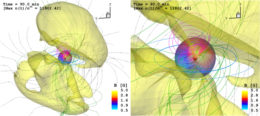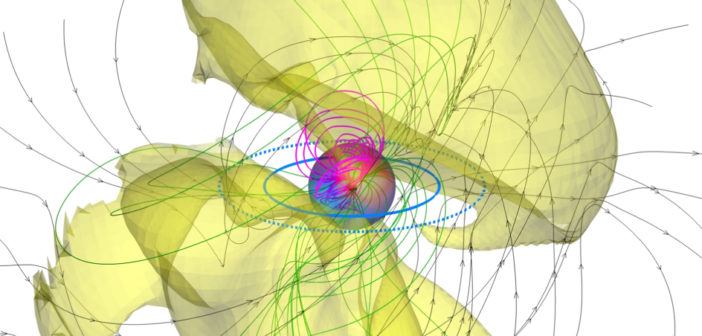
Model results showing the conditions 90 minutes after a coronal mass ejection for a field of view 175 times the stellar radius (left) and 60 times the stellar radius (right). The yellow lobes show the surface on which the plasma density is ten times higher than the typical density. Planetary orbits are shown in blue, and the sphere surrounding the central star shows the magnetic field strength at half the distance to the inner planet. The magenta and green lines show the magnetic fields that loop back to the star’s surface or extend outward, respectively. Click for high-resolution version. [Fraschetti et al. 2022]
How do high-energy particles affect the atmospheres of exoplanets? For the two Neptune-sized planets closely orbiting AU Microscopii, it’s an important question. At just 22 million years old, AU Microscopii is highly active, producing high-energy particles that can, in extreme cases, cause a planet’s atmosphere to evaporate over time. In a recent publication, a team led by Federico Fraschetti (Center for Astrophysics ∣ Harvard & Smithsonian and Lunar and Planetary Laboratory) modeled the passage of high-energy particles as they travel outward from AU Microscopii. To understand how stellar coronal mass ejections — enormous explosions of plasma and magnetic fields from a star’s atmosphere — affect the passage of high-energy particles, the team compared their results for a quiescent environment to the turbulent aftermath of a coronal mass ejection. The images above and to the right show the model results for the coronal mass ejection case. Fraschetti and collaborators found that the disruption caused by a coronal mass ejection causes huge fluctuations in the number of high-energy particles that strike the planets, with the maximum particle flux reaching values 2–3 orders of magnitude higher than experienced by Earth. To learn more about how energetic particles navigate the complex plasma environment around a young star, be sure to read the full article below!
Citation
“Stellar Energetic Particle Transport in the Turbulent and CME-disrupted Stellar Wind of AU Microscopii,” Federico Fraschetti et al 2022 ApJ 937 126. doi:10.3847/1538-4357/ac86d7


